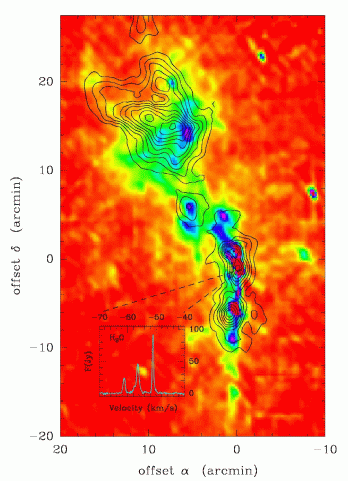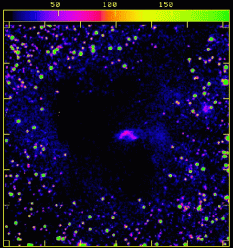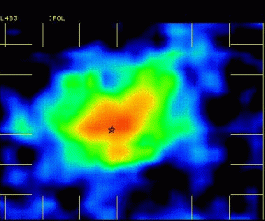Where stars are born
Molecular clouds with a density of 10-20 to
10-22 grammes per cm3 and temperatures in the order of 10
Kelvin degree![]() are
the seeds from which new stars are born. In fact, in these clouds, cold gas is
dense enough to collapse under the effect of a gravitational perturbation. With
the increase of the compression hotter and more compact globules of condensation
are created up to the point when, in the centre,
nuclear combustion of hydrogen
are
the seeds from which new stars are born. In fact, in these clouds, cold gas is
dense enough to collapse under the effect of a gravitational perturbation. With
the increase of the compression hotter and more compact globules of condensation
are created up to the point when, in the centre,
nuclear combustion of hydrogen![]() .
.
|
|
| |
|
Fig.1:
The emission of the molecular cloud L483 at infrared wavelengths. |
Fig. 2: The
same molecular cloud L483 observed at 1.3 mm wavelength, which
corresponds to an emission line of CO. |
A part from hydrogen and helium, this gas also contains carbon monoxide (CO), cyanogen radical (CN), methylidyne radical (CH), hydroxyl radical (OH), water (H20), formaldehyde (H2CO), ammonia (NH3), etc. - material produced mainly by supernovae.
 |
Fig. 3:
An example of a molecular cloud in our galaxy. The false colours represent
emission at 25 microns (Infrared). The black contour lines represent emission
of CO (1.3 mm). The graph in the bottom left corner shows speed and emission
at the H2O line in a region of the
cloud. (Credits: Brand & Wouterloot) |
The Webweavers: Last modified Mon, 22 Mar 2004 10:03:01 GMT

